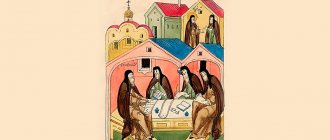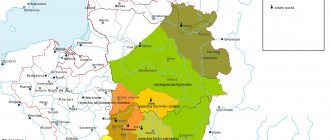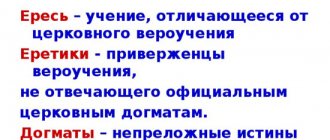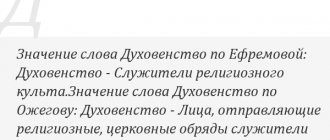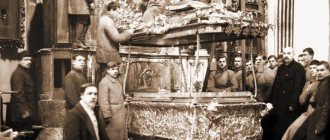Society is a complex natural-historical structure, the elements of which are people. Their connections and relationships are determined by a certain social status, the functions and roles they perform, the norms and values generally accepted in a given system, as well as their individual qualities. Society is usually divided into three types: traditional, industrial and post-industrial. Each of them has its own distinctive features and functions.
This article will look at traditional society (definition, characteristics, basics, examples, etc.).
What it is?
A modern industrialist, new to history and social science, may not understand what a “traditional society” is. We will consider the definition of this concept further.
Traditional society functions on the basis of traditional values. It is often perceived as tribal, primitive and backward feudal. It is a society with an agrarian structure, with sedentary structures and with methods of social and cultural regulation based on traditions. It is believed that for most of its history, humanity was at this stage.
Traditional society, the definition of which is discussed in this article, is a collection of groups of people at different stages of development and without a mature industrial complex. The determining factor in the development of such social units is agriculture.
Features of the norm of raising children in a patriarchal family
Raising children in such unions is considered to be strict, but fair - the values of modern society are instilled in the child from childhood, but based on the respect of the previous generation.
Here are some tips for communicating with a child that patriarchal parents use.
Always take responsibility for yourself and your actions
You should not give the child the right to decide for the parent. For example, you want to punish your son for spilling sauce on his new pants. There is no need to ask what you should do with it - even as a joke. A parent is a model of behavior for a child, and therefore watch your authority.
Take time to relax
Parents will be able to raise a child in a calm atmosphere only when they put themselves and their thoughts in order. Your emotions directly affect your children.
Don't take your problems out on your children
A tough day at work or a bad shopping trip? There is no need to express your negative emotions in front of your child; it is even worse if you simply decide to take it all out on him. It’s easier for you in this case, but worse for the children. Yes, it’s not easy to catch such situations at first, but you need to develop the habit of constantly analyzing your words - this will make it much easier to get used to.
Give choice when needed
In order for your baby to grow up as a free, independent person, you need not only to instill family values, but also to take care of his own choices - be it even candy or filling for pies. If you don’t want to get an ungrateful child, then from childhood teach your children to want to decide something on their own.
Refer to the experience of the previous generation, but also do not forget about modern values
The best way to raise a worthy person is to transfer into his behavior the traditions and values that your family has adhered to for centuries. Don’t forget that you are the successors of history, and therefore you can bring something new to it. When the child grows up, he will thank you for his proper upbringing.
And we offer to help you with this. The family tree is the embodiment of the traditions of your family name, its noble history. Our specialists will not only create a Pedigree Book according to your wishes, but will also help you fill it out.
Let the child feel that he is absolutely free
A patriarchal family is characterized by domineering concern for its loved ones. That is, this is a situation when it seems to the child that everything is happening according to the “laws of the streets,” although in fact you yourself are completely and completely in control of the circumstances. The child’s behavior may vary: he will either go with the flow or begin to actively fight the existing situation. In the first case, the child must be rescued immediately, otherwise troubles are inevitable. In the second, it is worth observing and at first maintaining the position of a peacemaker. Especially when the child trusts you and tells you all his secrets.
Many social studies textbooks say that a patriarchal family is characterized by total surveillance of the wife and children and is characterized by control over all processes in the house. However, this approach has become obsolete and can be detrimental to a marriage.
Characteristics of a traditional society
A traditional society is characterized by the following features:
1. Low production rates, satisfying people's needs at a minimum level. 2. High energy intensity. 3. Failure to accept innovations. 4. Strict regulation and control of the behavior of people, social structures, institutions, and customs. 5. As a rule, in a traditional society any manifestation of personal freedom is prohibited. 6. Social formations, sanctified by traditions, are considered unshakable - even the thought of their possible changes is perceived as criminal.
In the dictionary Complete accentuated paradigm according to A. A. Zaliznya
patriarchal, patriarchal, patriarchal, patriarchal, patriarchal, patriarchal, patriarchal, patriarchal, patriarchal, patriarchal, patriarchal, patriarchal, patriarchal, patriarchal, patriarchal, patriarchal, patriarchal, patriarchal, patriarchal, patriarchal, patriarchal, patriarchal, patriarchal, patriarchal, patriarchal, patriarchal, patriarchal, patriarchal, patriarchal, patriarchal, patriarchal, patriarchal, patriarchal, more patriarchal, more patriarchal, more patriarchal, more patriarchal
Economy of traditional society
Traditional society is considered agrarian, as it is based on agriculture. Its functioning depends on the cultivation of crops using a plow and draft animals. Thus, the same piece of land could be cultivated several times, resulting in permanent settlements.
Traditional society is also characterized by the predominant use of manual labor, an extensive method of production, and the absence of market forms of trade (the predominance of exchange and redistribution). This led to the enrichment of individuals or classes.
The forms of ownership in such structures are, as a rule, collective. Any manifestations of individualism are not accepted and rejected by society, and are also considered dangerous, as they violate the established order and traditional balance. There is no impetus for the development of science and culture, so extensive technologies are used in all areas.
Patriarchy
Patriarchy in the family presupposes the authority and autocracy of the man. Many researchers believe that the history of mankind was originally formed as a history of patriarchy (male dominance).
Thus, the English sociologist E. Giddens wrote that most known societies were patriarchal, although there are differences in the degree of patriarchy and variations in the power of men.
“Although the roles played by men and women in different cultures may differ significantly, no society has yet been discovered in which women have more power than men.”
The universal prevalence of patriarchy, according to the researcher, is not due to the dominance of male physical strength, but primarily to the maternal functions of women, due to the fact that childbirth and childcare make women really dependent on men in all respects, including material ones.
Political structure
The political sphere in such a society is characterized by authoritarian power, which is inherited. This is explained by the fact that only in this way can traditions be maintained for a long time. The management system in such a society was quite primitive (hereditary power was in the hands of the elders). The people actually had no influence on politics.
Often there is an idea about the divine origin of the person in whose hands the power was. In this regard, politics is actually completely subordinated to religion and is carried out only according to sacred instructions. The combination of secular and spiritual power made possible the increasing subordination of people to the state. This, in turn, strengthened the stability of a traditional type of society.
Family: patriarchy, matriarchy or equality?
Summary:
Good day, dear readers! Let's take a break from the law, I propose to talk about the family. Types of family structure, depending on the supremacy of a man or a woman in it, can be divided into: matriarchy, patriarchy and equality. Let's talk a little about each of these types, just speculate, without delving into the jungle of sociology and history.
Social relations
In the sphere of social relations, the following features of traditional society can be distinguished:
1. Patriarchal structure. 2. The main purpose of the functioning of such a society is to maintain human life and avoid its extinction as a species. 3. Low level of social mobility. 4. Traditional society is characterized by division into classes. Each of them played a different social role.
5. Personality assessment in terms of the place that people occupy in the hierarchical structure. 6. A person does not feel like an individual; he considers only his belonging to a certain group or community.
Useful video
The patriarchal type of family structure has become obsolete in many European countries, but there are isolated cases of unquestioning submission to a man. Psychologists say that only insecure individuals with low self-esteem can exist in it.
Still, one should not neglect the advantages that this form of relationship guarantees: the absence of abandoned children, disadvantaged elderly people, respect and veneration for elders, responsibility for one’s actions, mutual assistance.
Sources:
https://www.syl.ru/article/199910/new_patriarhalnaya-semya-krizis-v-traditsionnom-ustroystve-obschestva https://xn—-dtbebvqepcbbtq4r.xn--p1ai/blog/patriarxalnyj-tip-semi https: //religiya.guru/polezno-znat/traditsionnaya-patriarhalnaya-semya-chto-eto-takoe.html
Relationships with nature and the environment
The influence of traditional society on nature was primitive and insignificant. This was explained by low-waste production represented by cattle breeding and agriculture. Also, in some societies there were certain religious rules condemning the pollution of nature.
It was closed in relation to the outside world. Traditional society did its best to protect itself from outside invasions and any external influence. As a result, man perceived life as static and unchanging. Qualitative changes in such societies occurred very slowly, and revolutionary changes were perceived extremely painfully.
Gender equality
We seem to have sorted out patriarchy and matriarchy, let’s talk about equality.
Equality at its core implies equal rights, opportunities and responsibilities for women and men. At first glance, everything is fine, everyone is equal, everyone is happy. But is it really that simple?
Is it so good when the natural essences of the sexes are erased:
- A man is a breadwinner, a protector,
- A woman is a gentle, affectionate keeper of the hearth.
And doesn’t equality lead to artificial “genderlessness”: when women are insufficient in feminine strength, and men are insufficient in masculine strength? In H.G. Wells's novel The Time Machine, a time traveler finds himself in the world of the future and sees that "scientific and technological progress" (materialism) on Earth has led to the fact that asexual humanity has reached a state of "absolute peace", that is, balance ("complete harmony") as stagnation and extinction.
After all, with equality: relationships between a man and a woman are built not on the principle of complementarity, but on the principle of interchangeability. Is such equality necessary?
I do not undertake to criticize any of the types of family building:
- In patriarchy, a man dominates and supports his wife, keeping her in a tight grip;
- In matriarchy, a woman does what she wants, has children from whomever she wants, but also raises them herself, without support, and no one is obliged to feed her;
- If we are talking about equality, then investments are required from both, and there is no way without mutual respect.
The main thing is that the views of a woman and a man on building relationships coincide. After all, we are all different: some like to command, others to obey, one is used to being strong, the other is weak by nature. Everyone has their own choice: what type of relationship to build, and there is no right or wrong here. The main thing is that it suits both.
Which of these three systems: matriarchy, patriarchy, equality – seems more attractive to you, dear readers? I invite you to share your opinion in the comments.
Thank you for attention.
Information from sources used:
You may be interested in the publication:
“Mom said I was a girl”: or parents’ argument about what gender their child is
Source
Traditional and industrial society: differences
Industrial society arose in the 18th century as a result of industrial revolutions, primarily in England and France.
Some of its distinctive features should be highlighted. 1. Creation of large machine production. 2. Standardization of parts and assemblies of various mechanisms. This made mass production possible. 3. Another important distinguishing feature is urbanization (the growth of cities and the resettlement of a significant part of the population on their territory). 4. Division of labor and its specialization.
Traditional and industrial societies have significant differences. The first is characterized by a natural division of labor. Traditional values and patriarchal structure prevail here, and there is no mass production.
Post-industrial society should also be highlighted. Traditional, in contrast, aims to extract natural resources, rather than collect information and store it.
Examples of Traditional Society: China
Vivid examples of a traditional type of society can be found in the East in the Middle Ages and modern times. Among them, India, China, Japan, and the Ottoman Empire should be highlighted.
Since ancient times, China has been distinguished by strong state power. According to the nature of evolution, the society of this country developed cyclically. China is characterized by a constant alternation of several eras (development, crisis, social explosion). It should also be noted the unity of spiritual and religious authorities in this country. According to tradition, the emperor received the so-called “Mandate of Heaven” - divine permission to rule.
III. Church governing bodies
In 1589, under Tsar Theodore Ioannovich, through the efforts of the boyar Boris Godunov, the Patriarchate was established in Rus'. The first Moscow Patriarch, Saint Job, was installed with the participation of the Ecumenical Patriarch Jeremiah II, who was then in Russia to collect alms. In connection with this act, a “Laid Charter” was drawn up, which is placed at the beginning of the “Helmsman’s Book”.
The “Laid Charter on the Establishment of the Moscow Patriarchate” is one of the most important documents in the history of the Russian Church, the Russian state, as well as in the sphere of relations between the Local Orthodox Churches. The reflection in its text of the idea of Elder Philotheus about the Third Rome also gives it the character of a monument of political, legal and theological thought.
At the same time, of particular importance is the fact that it bears the signatures of not only Russian bishops, archimandrites and abbots, but also the signature of the Patriarch of Constantinople Jeremiah, which stands in the first place, along with the signatures of Metropolitan Hierotheus of Monemvasia, Archbishop Arsenios of Elasson and the Greek Archimandrite Christopher. From the formal legal side, the “Laid Charter” is therefore a document that belongs equally to both Moscow and Constantinople. True, from the point of view of the creation of this text, it is a product of the royal office. Patriarch Jeremiah and the Greek bishops put their signatures on the document, to put it mildly, without enthusiasm. Metropolitan Hierotheus of Monemvasia did not want to sign the “Laid Charter” for a long time. “What kind of certificate is this? - he interrogated clerk A. Shchelkalov. “And what should I sign in it?” Shchelkalov explained: “It is written here how you installed the Patriarch and how you came here.” - “Then why not write it in Greek and why not let it be heard first?..” Hierotheus did not sign for a long time, saying that he feared that the Church of God would be divided and another chapter would appear in it and something would happen great schism. Hierotheus admits that, in the end, he signed the letter only out of fear that he would not be drowned in the Moscow River. Apparently, the royal bailiffs intimidated Hierotheus as a disobedient to the royal will. Jeremiah had to intercede for him and even, to calm his friend’s conscience, he performed a ritual of casting a spell on the Russians if they committed the schism that Hierotheus feared290. This is how the circumstances of the signing of the “Certificate” look like in the view of the famous Russian historian A.V. Kartashev, obviously quite reliable.
These curious circumstances associated with putting signatures on the document undoubtedly indicate hesitation on the part of the Greek bishops. Nevertheless, they nevertheless signed the “Laid in Letter”, which means that although it may have contained expressions that were inconvenient for them, there were none that were completely unacceptable. It would still be absurd to assume that the very contents of the “Laid Charter” were not known to the Greeks. In any case, we have reason, under all the peculiar circumstances of the preparation of the “Charter,” to consider it as an agreed document.
There is a place in the “Laid Letter” in which Elder Philotheus’s idea about the Third Rome is reproduced. This place was at one time the subject of both textual and substantive research by N.V. Sinitsina291. And the conclusions she made are, in general, adequate. It seems, however, appropriate to place special emphasis on the theological and canonical aspects of the problem. The following speech is put into the mouth of the Patriarch of New Rome in the “Laid Charter”: “In truth, the Holy Spirit abides in you, the pious king (meaning Theodore, the son of Ivan the Terrible, who then occupied the royal throne. - V. Ts.), and from God your thought will be translated into action (we are talking about the establishment of the Patriarchate in Moscow. - V. Ts.) rightly and truly your noble undertaking, and our humility and the entire Consecrated Council will accomplish that great work. Since the old Rome fell through the Apolinarian heresy, the second Rome, which is Constantinople, has the Hagarian grandsons from the godless Turks, but yours, O pious king, the great Russian kingdom, the third Rome, surpasses all in piety, and all the pious kingdoms have gathered into yours, and you are the only Christian king under heaven who is called throughout the universe, in all Christians, and by God’s Providence and the Most Pure Mother of God’s mercy and prayers for the sake of the new miracle workers of the great Russian kingdom Peter, and Alexy, and Jonah, and by your royal request from God, your royal advice, this is a great task for the performer.”292
Let’s compare this passage with Elder Philotheus’s own words according to the most authentic text, undoubtedly the original letter to the sovereign’s clerk Mikhail Grigorievich Misyura-Munekhin: “Yes, O Christ-loving and God-loving one, consider that the entire Christian kingdom has come to an end and has descended into the one kingdom of our sovereign, according to prophetic books, that is, the Roman kingdom. Two of Rome have fallen, and the third stands, and the fourth will not exist.”293
The main difference between the formula contained in the “Laid Charter” and the corresponding passage from the message of Elder Philotheus is, undoubtedly, the absence in the “Charter” of a prophetic statement that there will not be a fourth Rome. It is now difficult for us to say how, in the process of drawing up the document, this idea of Philotheus ended up being excluded from the “Laid Down Charter”: was it done at the request of the Greek side or was it decided in the very office that produced the document, because it was foreseen that the Greeks would not agree to inclusion in the text this document, so demanding and, on the basis of dogmas and canons, the elder’s unprovable thought, or the prophecy that Moscow is the last Rome and there will never be a fourth, was recognized by the compilers of the “Charter” in Moscow as inappropriate in an official church document, related to the relationship between the two Local Churches. The elimination of this formula deprives the document in question of its apocalyptic sharpness and eschatological perspective, so important for Elder Philotheus himself and, undoubtedly, muted in the later understanding of Philotheus’s ideas, when, however, the idea that there would be no fourth Rome became very popular and common, but , having lost Filofeev’s apocalyptic pathos, acquired a triumphalist sound.
Be that as it may, it is precisely the absence of this essential element from the ideological structure of Elder Philotheus in the “Laid-up Charter” that testifies to the critical approach of its compilers to the ideas borrowed from Philotheus, and therefore allows us to more thoroughly accept the words included in the “Charter”, as an expression of a coordinated position officially adopted by the hierarchs of not only the Russian, but also the Constantinople Church.
What meaning could the publishers of the “Charter” put into the formula about Moscow – the third Rome? To answer this question, one should read more carefully into the text of Elder Philotheus in order to offer an adequate interpretation of his statements about the fall of the first and new Rome. The first Rome, according to Philotheus, fell due to the heresy of Apollinaris. There is no mention of it in the above quotation, but it is spoken of elsewhere in the message. Connecting this heresy with the peculiarities of the Roman Catholic dogma is incorrect from a historical and dogmatic point of view: the Roman Church undoubtedly rejects and has always rejected the heresy of Apollinaris, in the exposition of which Elder Philotheus also cites the judgments of the extreme monophysite Eutyches, appropriating them to Apollinaris, to which the Roman The church, of course, never had anything to do with it. The elder connects Apollinaria with the teachings of the Roman Church through unleavened bread, the use of which in the Sacrament of the Eucharist in the Roman Church was the subject of particularly heated controversy between the Christian East and the Christian West, but, mainly, in that era when canonical communication between Old and New Rome was still preserved, obscuring the theologically more significant, completely dogmatic question of the filioque. In our context, Philotheus’ historical and dogmatic incorrectness is not relevant, because he is not interested in the dogmatic question in itself; it was only important for him to state that there is an element of heresy in the doctrine of the Roman Church. Consequently, Moscow, in this context the Russian Church, has preserved the Orthodox teaching handed down from the Apostles and Fathers in intact purity.
The fall of the second, New Rome is explained by Philotheus in a different way, without any relation to dogmatic issues. Although after the Council of Florence and the conquest of Constantinople by the Turks in Moscow there were suspicions about the purity of Orthodoxy among the Greeks, which later became one of the main, if not the main reason for the Old Believer schism, these suspicions, naturally, could not be reflected in the “Laid Charter”. N.V. Sinitsyna wrote about this: “The most significant characteristic feature of the concept of “Third Rome” as part of the charter of 1589 is its significant weakening (that is, the concept of an anti-Greek orientation), and this is quite understandable in the context of the charter with its appeal to the authority of the Sanctified Council of the “great Russian and Greek kingdoms”, “the entire Greek Council” and the Eastern Patriarchs”294. This statement is true only if we compare the idea of the Third Rome, as it is presented in the “Laid Charter”, with the fullness of the meanings that were put into it in various Russian monuments of an earlier era, but such a conclusion cannot be drawn on the basis of the text itself Elder Philotheus. In what he writes about the fall of Constantinople, it is impossible to detect an anti-Greek tendency: “Even though the walls and pillars and trench coats of the great Rome were not captured, but their souls were captured from the devil for the sake of unleavened bread. If the Agarins instilled the Greek kingdom without harming their faith, they would force the Greeks to retreat from the faith.”295 The anti-Latin passage is obvious, but there is nothing anti-Greek here; moreover, in this phrase one can also sense an element of some kind of benevolence towards the enslavers of the Greeks themselves, who do not force them to “apostate from the faith.”
In the message, however, there is something else: “Ninety years since the Greek kingdom was ruined and was not built up, this whole thing happened as a sin for our sakes, since they betrayed the Orthodox Greek faith in Latinism.”296 But, on the one hand, this accusation of betrayal of the faith, obviously, still applies not to all Greeks, but to the Uniate leaders of the Ferraro-Florence Council, and on the other hand, it is a reference to the sins of not only the Greeks, but “our sins” that is, all of us, speaks for itself. We are talking here about universal sinfulness, as the original cause of both personal troubles and social, historical catastrophes. The traitors to the Orthodox faith at the council in Florence were condemned by the Orthodox Greeks themselves - the followers of St. Mark of Ephesus; They could not deny the idea of universal sinfulness, so the Greeks should not have seen anything anti-Greek in the quoted words. Thus, the only meaning of the mention of the fall of the Second Rome both in Philotheus and in the “Laid Charter” is to state the fact of the conquest of Constantinople by the Ottomans and, as a result of this conquest, the termination of the existence of the Orthodox empire on the Bosphorus. Consequently, Moscow, here no longer in the sense of the Russian Church, but of the Russian kingdom, has become the Third Rome because it is an Orthodox state independent of the authorities of other faiths.
But this, of course, is not all that we can glean from the idea of the Third Rome, as it is expressed both in the messages of the elder and in the “Laid Charter” on the establishment of the patriarchate. Indirectly, the very naming of Moscow as the Third Rome already contains the idea that Rome is imperishable and in this sense eternal, for after the fall of one Rome another arises, or, better said, the same Rome, but in a different place. In his letter to Misyura Munekhin, Philotheus provides the following justification for the idea of the eternity of Rome: “Otherwise, the Roman kingdom is indestructible, as the Lord has written into Roman power”297 - an argument that is dogmatically acceptable only if the Roman kingdom means the Church of Christ. But these words obviously contain a different, more literal and historiosophical meaning, which, of course, cannot be justified by a dogmatically presented biblical argument.
In conjunction with the idea of the indestructibility of the Roman kingdom is the idea of the fundamental uniqueness, the uniqueness of Rome. Elder Philotheus writes to the sovereign’s clerk: “The entire Christian kingdom has come to an end and has descended into the one kingdom of our sovereign”298, and in the “Laid Charter” we find, in essence, an expanded paraphrase of the same thought: “Yours, O pious Tsar, the great Russian kingdom, the third Rome, surpassing all in piety, and all the pious kingdoms have gathered into yours, and you are the only Christian king under heaven who is called throughout the entire universe.”299
Thus, summarizing what has been said, we can conclude: the idea of the succession of Moscow to New Rome, present in the “Laid Charter,” includes the idea that Russia is an Orthodox autocratic state and that the political center of the Orthodox world is Moscow.
In May 1590, Patriarch Jeremiah convened a Council in Constantinople, in which Patriarch Joachim of Antioch and Sophronius of Jerusalem participated. Having told the assembled hierarchs about the wealth and greatness of the Moscow churches, the generosity and piety of the Russian Tsar and about the Tsar’s request to establish the Russian Patriarchate, he asked the council to approve his “chrisovull” - “The laid down document on the installation of a Patriarch in Moscow.” The Eastern Patriarchs recognized this matter as “gracious and blessed” and adopted a resolution: “First, we recognize and confirm the installation of Patriarch Job in the reigning city of Moscow, may he continue to be honored and named with us - the Patriarchs, and there will be a rank for him in prayers after Jerusalem ; and at the head and beginning he should hold the Apostolic Throne of Constantinograd, as other Patriarchs hold; secondly, the Patriarchal name and honor has now been given and approved not only to Mr. Job, but we decree that the Moscow Council will appoint Patriarchs in Russia according to the rules, as began from this fellow servant of our humility and in the Holy Spirit of our beloved brother Job. For this reason, this document was approved as a keepsake forever, in the summer of 1590, in the month of May.”300 The “Charter” was signed by the Patriarchs of Constantinople, Antioch, Jerusalem (the See of Alexandria was then widowed) and 42 metropolitans, 19 archbishops and 20 bishops who participated in the actions of the council.
In the conciliar act, the Russian sovereign is called “the only tsar on earth now, the great Orthodox,” but there is no mention of the Third Rome in this act. The reasons for this could be different. But among them, undoubtedly, was the fact that at this Council the question was not about the kingdom, but a purely ecclesiastical one, and, in particular, about the diptych. The Eastern Patriarchs did not want to place the Patriarch of Moscow in the diptych in front of themselves, following the Patriarch of Constantinople, as they had hoped for in Moscow. The Moscow Patriarch was given fifth place in the diptych, after the Eastern Patriarchs. Meanwhile, according to the 3rd canon of the Second Ecumenical Council, “Let the bishop of Constantinople have the advantage of honor over the bishop of Rome, because that city is New Rome.” If Moscow at the Council in Constantinople had been officially recognized by the Eastern Patriarchs as the Third Rome, then if we follow the logic of the fathers of the Second Ecumenical Council, and it would be natural to follow it, the Third Rome should have been given a place in the diptych immediately after the New Rome, that is, the second, and not at all the fifth. They did not want to do this, although at the same time they observed appropriate delicacy in relation to the Russian Tsar, the patron and protector of the Orthodox in the East. He was recognized as the only Orthodox Tsar, but Moscow was not called the Third Rome in order to place its Patriarchal Throne after all the Eastern ones. In Moscow, they were not happy with this decision about the place of the Russian Church in the Orthodox diptych, but they came to terms with it.
Japan
The development of Japan in the Middle Ages and in modern times also suggests that there was a traditional society here, the definition of which is discussed in this article. The entire population of the Land of the Rising Sun was divided into 4 estates. The first is the samurai, daimyo and shogun (personified the highest secular power). They occupied a privileged position and had the right to bear arms. The second estate were peasants who owned land as a hereditary holding. The third is artisans and the fourth is merchants. It should be noted that trade in Japan was considered an unworthy activity. It is also worth highlighting the strict regulation of the social life of each class.
Unlike other traditional eastern countries, in Japan there was no unity of supreme secular and spiritual authority. The first was personified by the shogun. In his hands was most of the lands and enormous power. There was also an emperor (tenno) in Japan. He was the personification of spiritual power.
Definition
A traditional society is a community in which everything is governed by values. Much more attention is paid to the preservation of numerous traditions in this class than to the development of the partnership itself. A characteristic feature of traditional society is the presence of a rigid hierarchy and the existence of a clear division into classes.
The traditional society is agrarian. This can be explained by the fact that work on the land is part of the long-standing values that are characteristic of this type of social system. The traditional caste has been preserved in its original form in some countries of Africa, Asia and the East.
